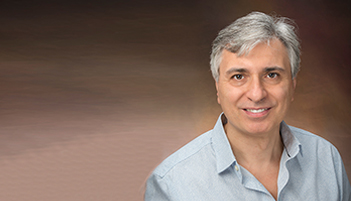HOW CAN WE HELP YOU? Call 1-800-TRY-CHOP
In This Section
From Sci-Fi to Real Life, Stefano Rivella, PhD, on the Verge of Discovery
 By Nancy McCann
By Nancy McCann
Bundled up in winter clothes from head to toe, 7-year-old Eric rolls a snowball around the backyard with his older brother, building it into a sizeable snowman. Mom, watching from her perch at the kitchen window, can hear her boys laughing — until — Eric doubles over in acute chest pain, crying out for her. Rushing to his side, she wonders how many more of these excruciating episodes and trips to the hospital Eric can endure.
Eric has sickle cell disease (SCD), an inherited blood disorder characterized by abrupt pain crisis which can be debilitating during its frequency. SCD is characterized by the abnormal shape of oxygen-carrying red cells. Instead of round and pliable, sickle cells are rigid and moon-shaped, thus the name. Because of their deformity, they can get lodged in blood vessels — unable to deliver oxygen to a particular area of the body — leading to cell damage and causing agonizing pain, stroke, or even death. Anemia and frequent infections are also common symptoms. Current treatments such as medications and repeated blood transfusions that aim to manage symptoms can be complicated and expensive. Bone marrow transplant is the only curative option, but appropriate HLA-matched donors often are not available.
Help is on the Way
Stefano Rivella, PhD, a research faculty member in the Division of Hematology at Children’s Hospital of Philadelphia and scientific director (together with medical director Janet Kwiatkowski, MD, MSCE) of the Comprehensive Center for the Cure of Sickle Cell Disease and Other Red Blood Cell Disorders (CuRED), has been studying SCD, beta thalassemia, and other red blood disorders for decades. He and his research team in the Rivella Lab housed in Abramson Research Center are developing a novel gene therapy for Eric and others who suffer from these debilitating diseases. The idea is to transfer a new and functional version of the mutated gene, via a virus vector, into cells taken from the patient’s bone marrow. The new blood stem cells are then infused into the patient.
“This is addressing where we need to fix the problem — in the bone marrow where the red blood cells are made,” Dr. Rivella said. “We’ve been doing this with animal models but are preparing to move to patients as soon as possible.”
The entire process, from the vector manufacturing to mixing cells with the virus vector, will be conducted on CHOP’s campus in the new Clinical Vector Core, part of the Raymond G. Perelman Center for Cellular and Molecular Therapeutics, and the Cell Therapy and Transplant Section.
“This integrated process is uniquely available at CHOP, and not only makes sure everything is done correctly but also protects the patient from potential contamination,” Dr. Rivella explained. “When everything is ready, we will infuse the patient in the clinic here at CHOP. And then, of course, we will monitor.”
Getting Started
While growing up in Italy, Dr. Rivella was always interested in science. “My first passions were astrophysics and genetics,” he said in his lilting, accented English. But before heading off to University of Pavia, he knew he had to make a choice. His guiding question: Which one would have a more profound impact on humans?
“I thought astrophysics was faraway, not tangible, and difficult to bring to reality here on my planet,” he said. His thoughts on the field of genetics, although sci-fi-like at the time, were more of, “Maybe one day we can really help people by working on diseases and understanding better why some people have problems and others don’t — and maybe we can cure them.”
His postdoctorate work brought him to the U.S. to Memorial Sloan Kettering Cancer Center in New York City. Then, after 13 years as a professor of genetic medicine at Weill Cornell Medical College, he headed down Interstate 95 to Philadelphia and CHOP.
Disneyland in Philadelphia
“CHOP is like Disneyland for scientists,” Rivella said with a broad smile when asked about why he moved his lab and family to Philadelphia in 2015. “For scientists, this is a place where they can really play. As a child, you like to play with toys. As an adult scientist, you like to play with instruments in a space where you can invent. CHOP was right for me because of its infrastructure, community, and vision. CHOP was already interested in gene therapy, clinical trials were in the works, and people understood what I was talking about and working on. It is the perfect environment, the perfect people, the perfect vision. Disneyland for scientists — that’s how I really feel.
“I think the best institutions are those that take a leap of faith to embrace new ideas. Sometimes you need to say crazy things. Out of 10 ideas, maybe three or four are really crazy, but maybe one of the 10 is the inspiration that’s going to change the world,” Rivella enthused. “The kind of place that says, ‘This is interesting, what can we do to help?’ Not, ‘Don’t waste your time; it’s too risky.’ That’s why I came to CHOP.”
And that’s his advice for the next generation of researchers: “Don’t be afraid to explore new avenues. Don’t be afraid of dreaming of what can be accomplished. And think of the implication that your science is going to have on society. My desire was gene therapy, but my ultimate desire is that gene therapy can be used by everybody, not just people able to come to CHOP. Making this technology available to everyone, no matter if they are in poor or wealthy countries, because that could change the life of a child.”
Like Eric.